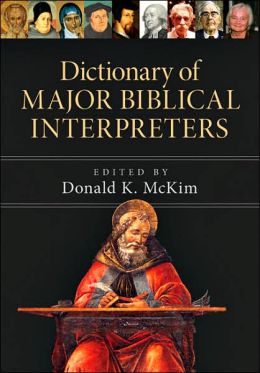Donald McKim: Dictionary of Major Biblical Interpreters
 Donald K. McKim, ed., Dictionary of Major Biblical Interpreters (Leicester: InterVarsity, 2007), 1106 pages, ISBN 9780830829279.
Donald K. McKim, ed., Dictionary of Major Biblical Interpreters (Leicester: InterVarsity, 2007), 1106 pages, ISBN 9780830829279.
This book is a revised edition of the Historical Handbook of Major Biblical Interpreters (1998). In concept, the work is ingenious—I know of no other work that treats major figures in the interpretation of Scripture in this way. With respect to the working out of this concept, however, the Dictionary of Major Biblical Interpreters has a number of serious drawbacks. Whether one can overcome these drawbacks, of course, will largely depend on how much one already knows, but that is an especially unfortunate way to have to read a reference work.
The Dictionary consists of more than 200 articles on “major biblical interpreters”, introduced by a series of overviews of interpretive trends within different periods, divided (where applicable) between North America and Europe. The quality of the articles is often very high, although it is hardly consistent. All the article writers were naturally drawn to their subjects’ work, but there are times when a bit more objectivity would have helped. Indeed, some of the articles are too adulatory for a dictionary—for example, the over-long article on Brevard Childs, written by one of his students, is a shameless mixture of hagiography and apology. (The “studies” listed at the end of that article exclude the works of Childs’s detractors, although he had several. Other articles in the Dictionary follow a much more objective policy with their bibliographies.)
The historical overview articles are uneven in quality. The articles on “Biblical Interpretation in Europe in the Twentieth Century” and “Biblical Interpretation in the Eighteenth and Nineteenth Centuries” are extremely tendentious: they seem to have no other object than to paint historical criticism as a fall from faithful reading practices. They attempt to make this case in the usual way: by associating everything undesirable (from the writers’ viewpoint) with the Enlightenment, even to the point of attributing the “modernist” concern for authorial intention to a (supposed) nineteenth-century development. (Unfortunately for the authors of these articles, other entries within the same volume set the record straight on some of this nonsense—e.g., the article on John Calvin speaks in very clear terms of the sixteenth-century reformer’s devotion to authorial intention as the primary hermeneutical goal.) These two articles sometimes get the more value-neutral facts wrong as well—e.g., Schleiermacher and Lachmann are credited with the idea that Mark was a source for Matthew and Luke (p. 62), but those early source critics argued only that Mark gave the clearest representation of the original gospel narrative that underlay all the synoptic gospels. In short, readers should look elsewhere if they want a reasonably objective history of biblical interpretation in these periods. It is especially unfortunate that articles like this can make it into a reference work. The editors of reference works usually set ground rules to avoid problems of this type.
Unfortunately, there are other significant problems with the Dictionary as well. The high quality of presentation that one finds in many of the articles on individual biblical interpreters is somewhat offset by the rather tendentious selection of “biblical interpreters”. It is difficult to know why some figures were chosen for inclusion, while others were excluded. Those familiar with important names within the biblical studies guild might be very surprised to learn that there is no entry for E. P. Sanders, arguably the most important figure in the study of Paul in the twentieth century (and one of the most important contributors to historical Jesus research as well). Those looking for other major interpreters of Paul will be equally surprised to find no entry for Krister Stendahl. Omissions like these are so huge that they border on bizarre. One cannot help but wonder whether these omissions reflect a prejudice against the so-called New Perspective on Paul, a general approach for which Sanders and Stendahl might be considered the founders. (This theory finds support in the only slightly less surprising omission of two other major figureheads of the New Perspective: N. T. Wright and James Dunn—although Dunn, oddly enough, is listed as a contributor to the Dictionary.) Whatever the explanation, the omission of names of this caliber is certainly strange. Indeed, failing to list Sanders or Stendahl in a list of 100 “major biblical interpreters” is like failing to list Jackie Robinson or Ted Williams in a list of 100 “major professional baseball players”.
Category: In Depth, Summer 2009


